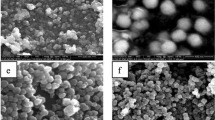Abstract
Hydrogels composed of glycidyl methacrylate dextran (GMD) and poly(acrylic acid, PAA) were prepared by UV irradiation method for colon-specific drug delivery. GMD was synthesized by coupling of glycidyl methacrylate to dextran in the presence of 4-(N,N-dimethylamino)pyridine. GMD was photo-polymerized by ammonium peroxydisulfate as initiating system in phosphate-buffered solution (0.1 M, pH 7.4). And then, acrylic acid monomer was added and subsequently heat-polymerized by 2,2′-azobisisobutyronitrile as an initiator. The hydrogels exhibited high swelling ratio (about 20) at 37°C, and showed a pH-dependent swelling behavior. In addition, the swelling ratio of the hydrogel was remarkably enhanced to about 45 times in the presence of dextranase at pH 7.4. The swelling-deswelling behavior proceeded reversibly for the GMD/PAA hydrogels between pH 2 and pH 7.4. Release of 5-aminosalicylic acid from the GMD/PAA hydrogels was evaluated in simulated gastrointestinal pH fluids in the absence or presence of dextranase. We concluded that the hydrogels prepared could be used as a dual-sensitive drug carrier for sequential release in gastrointestinal tract.
Similar content being viewed by others
References
Brannon-Peppas, L. and Peppas, N. A., Solute and penetrant diffusion in swellable polymers: IX. The mechanism of drug release from pH-sensitive swelling-controlled systems.J. Controlled Release, 8, 267–274 (1989).
Brondsted, H., Hovgaard, L., and Simonsen, J., Dextran hydrogels for colon-specific drug delivery. III.In vitro andin vivo degradation.S.T.P. Pharm. Sci., 5, 60–64 (1995a).
Brondsted, H., Hovgaard, L., and Simonsen, J., Dextran hydrogels for colon-specific drug delivery. IV. Comparative release mechanism of hydrocortisone and prednisolone phosphate.S.T.P. Pharm. Sci., 5, 65–69 (1995b).
Chen, J., Jo, S., and Park, K., Polysaccharide hydrogels for protein drug delivery.Carbohydr. Polym., 28, 69–76 (1995).
Chourasia, M. K. and Jain, S. K., Polysaccharides for Colon Targeted Drug Delivery.Drug Delivery, 11 129–148 (2004).
Dong, L. C. and Hoffman, A. S., A novel approach for preparation of pH-sensitive hydrogels for enteric drug delivery.J. Controlled Release, 15, 141–152 (1991).
Franssen, O., Vos, O. P., and Hennink, W. E., Delayed release of a model protein from enzymatically-degrading dextran hydrogels.J. Controlled Release, 44, 237–245 (1997).
Heller, J., Polymers for controlled parenteral delivery of peptides and proteins.Adv. Drug Deliv. Rev., 10, 163–204 (1993).
Hennink, W. E., Franssen, O., van Dijk-Wolthuis, W. N. E., and Talsma H., Dextran hydrogels for the controlled release of proteins.J. Controlled Release, 48, 107–114 (1997).
Hennink W. E., De Jong, S. J., Bos, G. W., Veldhuis, T. F. J., and van Nostrum C. F., Biodegradable dextran hydrogels crosslinked by stereocomplex formation for the controlled release of pharmaceutical proteins.Int. J. Pharm., 277, 99–104 (2004).
Hovgaard, L. and Brondsted, H., Dextran hydrogels for colonspecific drug delivery.J. Controlled Release, 36, 159–166 (1995).
Kamath, K. R. and Park, K., Biodegradable hydrogels in drug delivery.Adv. Drug Deliv. Rev., 11, 59–84 (1993).
Kikuchi, A. and Okano, T., Pulsatile drug release control using hydrogels.Adv. Drug Deliv. Rev., 54(1), 53–77 (2002).
Kim, I. S., Jeong, Y. I., and Kim, S. H., Self-assembled hydrogel nanoparticles composed of dextran and poly(ethylene glycol) macromer.Int. J. Pharm., 205, 109–116 (2000).
Kim, S. W., Bae, Y. H., and Okano, T., Hydrogels: swelling, drug loading and release.Pharm. Res., 9, 283–290 (1992).
Larsen, C., Harboe, E., Johansen, M., and Olesen, H. P., Macromolecular prodrugs. XVI. Colon-targeted delivery—comparison of the rate of release of naproxen from dextran ester prodrugs in homogenates of various segments of the pig gastrointestinal (GI) tract.Pharm. Res., 5, 995–999 (1989).
Molteni, L., Drug carriers in Biology and Medicine, ed. by Gregoriadis, G., Academic Press, London, p. 107–125, (1979).
Moriyama, K., Ooya, T., and Yui, N., Pulsatile peptide release from multi-layered hydrogel formulations consisting of poly(ethylene glycol)-grafted and ungrafted dextrans.J. Biomater. Sci. Polym. Ed., 10(12), 1251–1264 (1999).
Okano, T., Yui, N., Yokoyama, M., and Yoshida, R., Advances in Polymeric Systems for Drug Delivery. Gordon & Breach Science, Yverdon, (1994).
Park, K. and Park, H., Smart Hydrogels, in: J.C. Salamone (Ed.), Concise Polymeric Materials Encyclopedia, CRC Press, Boca Raton, p. 1476–1478, (1999).
Park, K., Shalaby, S. W. S., and Park, H., Biodegradable Hydrogels for Drug Delivery, Technomic Publishing Co., Lancaster, (1993).
Peppas, N. A., Hydrogels in Medicine and Pharmacy. Volumes I–III. CRC Press, Boca Raton, FL, (1987).
Pitarresi, G., Palumbo, F. S., Giammona, G., Casadei, M. A., and Moracci, F. M., Biodegradable hydrogels obtained by photocrosslinking of dextran and polyaspartamide derivatives.Biomaterials, 24, 4301–4313 (2003).
Poznansky, M. J. and Cleland, L. G., Drug Delivery Systems, ed. by Juliano, R. L., Oxford University Press, New York, p. 253–315, (1980).
Qiu, Y. and Park, K., Environment-sensitive hydrogels for drug delivery.Adv. Drug Deliv. Rev., 53, 321–339 (2001).
Sery, T. W. and Hehre, E. J., Degradation of dextrans by enzymes of intestinal bacteria.J. Bacteriol., 71, 373–380 (1956).
Shiino, D., Murata, Y., Kataoka, K., Koyama, Y., Yokoyama, M., Okano, T., and Sakurai, Y., Preparation and characterization of a glucose-responsive insulin-releasing polymer device.Biomaterials, 15(2), 121–128 (1994).
Siegel, R. A. and Firestone, B. A., Progress toward an implantable, self-regulating, mechanochemical insulin delivery system.Proc. Symp. Contr. Rel. Bioact. Mater., 15, 164–167 (1988).
Takagi, T., Takahashi, K., Aizawa, M., and Miyata, S., Proceedings of the First International Conference on Intelligent Materials. Technomic Publishing Co., Inc., Lancaster, PA, (1993).
Van Dijk-Wolthuis, W. N. E., Franssen, O., Talsma, H., van Steenbergen, M. J., Kettenes-van den Bosch, J. J., and Hennink, W. E., Synthesis, characterization and polymerization of glycidyl methacrylate derivatized dextran.Macromolecules, 28, 6317–6322 (1995).
Yoshida, R., Sakai, K., Okano, T., and Sakurai, Y., Pulsatile drug delivery systems using hydrogels.Adv. Drug Deliv. Rev., 11, 85–108 (1993).
Zhang, R., Tang, M., Bowyer, A., Eisenthal, R., and Hubble, J., A novel pH- and ionic-strength-sensitive carboxy methyl dextran hydrogel.Biomaterials, 26, 4677–4683 (2005).
Author information
Authors and Affiliations
Corresponding author
Rights and permissions
About this article
Cite this article
Kim, IS., Oh, IJ. Drug release from the enzyme-degradable and pH-sensitive hydrogel composed of glycidyl methacrylate dextran and poly(acrylic acid). Arch Pharm Res 28, 983–987 (2005). https://doi.org/10.1007/BF02973887
Received:
Issue Date:
DOI: https://doi.org/10.1007/BF02973887




